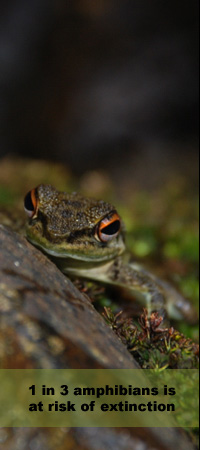|
Harlequin frogs are found in neotropics from Costa Rica to Bolivia. They belong to the genus Atelopus and include about 80 species, and probably 35 not yet described. The vast majority (80%) of the harlequin frog species lives in forested mountains where rainfall is abundant. Most of them have a limited range of distribution. Harlequin frogs are usually active day and night. Harlequin frogs are small-to-medium size amphibians (20-60 mm from the tip of the nose to the vent) with females always lager than males. Females have usually a different color under their ventral parts.
Rising temperatures, habitat destruction, and the spread of the deadly chytrid fungus have wiped out dozens of species of harlequin frogs in recent years. Further, most of the harlequin frog species are listed as critically endangered and endangered with a very high risk of extinction.
Artelopus andinus
is endemic to Peru from 1,000 to 2,000 meters elevation along the Cordillera Azúl. Male harlequin frogs of this species reach 27 mm and females 37 mm.
Status: critically endangered.

Artelopus boulengeri
is endemic to Ecuador from 900 to 2,000 meters elevation along the Cordilleras de Cutúcu and Cóndor. Male harlequin frogs of this species reach 49 mm and females 64 mm. This frog is known only from 6 localities.
Status: critically endangered.

Artelopus nanay
is endemic to Ecuador along the Cordilleras Occidental. Its known range is less than 10 km?. Male harlequin frogs of this species reach 28 mm and females 40 mm. This frog was observed for the last in 1989.
Status: critically endangered, possibly extinct.

Artelopus subornatus
is endemic to Colombia within the Cordilleras Occidental from 2,000 to 2,800 meters elevation. Male harlequin frogs of this species reach 30 mm and females 40 mm. This frog was observed for the last in 1993.
Status: critically endangered, possibly extinct.

Artelopus zeteki
is endemic to Panama within the Coclé and Panamá provinces from 430 to 900 meters elevation. Its known range is about 1,600 km. Male harlequin frogs of this species reach 40 mm and females 58 mm.
Status: critically endangered.

Continue on page 6
|
|

Atelopus varius a critically endangered harlequin frog Harlequin Frog found in Colombia, Costa Rica, and Panama. © 2005 Robert Puschendorf

The Panamanian golden frog (Atelopus zeteki) a critically endangered frog endemic to Panama. © 2004 John White
|









